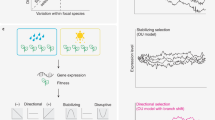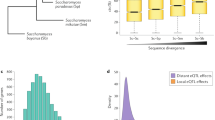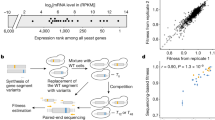Abstract
Phenotypic diversity is generated through changes in gene structure or gene regulation. The availability of full genomic sequences allows for the analysis of gene sequence evolution. In contrast, little is known about the principles driving the evolution of gene expression. Here we describe the differential transcriptional response of four closely related yeast species to a variety of environmental stresses. Genes containing a TATA box in their promoters show an increased interspecies variability in expression, independent of their functional association. Examining additional data sets, we find that this enhanced expression divergence of TATA-containing genes is consistent across all eukaryotes studied to date, including nematodes, fruit flies, plants and mammals. TATA-dependent regulation may enhance the sensitivity of gene expression to genetic perturbations, thus facilitating expression divergence at particular genetic loci.
This is a preview of subscription content, access via your institution
Access options
Subscribe to this journal
Receive 12 print issues and online access
$209.00 per year
only $17.42 per issue
Buy this article
- Purchase on Springer Link
- Instant access to full article PDF
Prices may be subject to local taxes which are calculated during checkout




Similar content being viewed by others
Accession codes
References
Khaitovich, P. et al. Parallel patterns of evolution in the genomes and transcriptomes of humans and chimpanzees. Science 309, 1850–1854 (2005).
Ranz, J.M., Castillo-Davis, C.I., Meiklejohn, C.D. & Hartl, D.L. Sex-dependent gene expression and evolution of the Drosophila transcriptome. Science 300, 1742–1745 (2003).
Rifkin, S.A., Houle, D., Kim, J. & White, K.P. A mutation accumulation assay reveals a broad capacity for rapid evolution of gene expression. Nature 438, 220–223 (2005).
Rifkin, S.A., Kim, J. & White, K.P. Evolution of gene expression in the Drosophila melanogaster subgroup. Nat. Genet. 33, 138–144 (2003).
Denver, D.R. et al. The transcriptional consequences of mutation and natural selection in Caenorhabditis elegans. Nat. Genet. 37, 544–548 (2005).
Vuylsteke, M., van Eeuwijk, F., Van Hummelen, P., Kuiper, M. & Zabeau, M. Genetic analysis of variation in gene expression in Arabidopsis thaliana. Genetics 171, 1267–1275 (2005).
Kliebenstein, D.J. et al. Genomic survey of gene expression diversity in Arabidopsis thaliana. Genetics 172, 1179–1189 (2006).
Gasch, A.P. et al. Conservation and evolution of cis-regulatory systems in ascomycete fungi. PLoS Biol. 2, e398 (2004).
Tanay, A., Regev, A. & Shamir, R. Conservation and evolvability in regulatory networks: the evolution of ribosomal regulation in yeast. Proc. Natl. Acad. Sci. USA 102, 7203–7208 (2005).
Ihmels, J. et al. Rewiring of the yeast transcriptional network through the evolution of motif usage. Science 309, 938–940 (2005).
Cliften, P. et al. Finding functional features in Saccharomyces genomes by phylogenetic footprinting. Science 301, 71–76 (2003).
Kellis, M., Patterson, N., Endrizzi, M., Birren, B. & Lander, E.S. Sequencing and comparison of yeast species to identify genes and regulatory elements. Nature 423, 241–254 (2003).
Edwards-Ingram, L.C. et al. Comparative genomic hybridization provides new insights into the molecular taxonomy of the Saccharomyces sensu stricto complex. Genome Res. 14, 1043–1051 (2004).
Ihmels, J. et al. Revealing modular organization in the yeast transcriptional network. Nat. Genet. 31, 370–377 (2002).
Townsend, J.P., Cavalieri, D. & Hartl, D.L. Population genetic variation in genome-wide gene expression. Mol. Biol. Evol. 20, 955–963 (2003).
Butler, J.E. & Kadonaga, J.T. The RNA polymerase II core promoter: a key component in the regulation of gene expression. Genes Dev. 16, 2583–2592 (2002).
Basehoar, A.D., Zanton, S.J. & Pugh, B.F. Identification and distinct regulation of yeast TATA box-containing genes. Cell 116, 699–709 (2004).
Patikoglou, G.A. et al. TATA element recognition by the TATA box-binding protein has been conserved throughout evolution. Genes Dev. 13, 3217–3230 (1999).
Gasch, A.P. et al. Genomic expression programs in the response of yeast cells to environmental changes. Mol. Biol. Cell 11, 4241–4257 (2000).
Su, A.I. et al. A gene atlas of the mouse and human protein-encoding transcriptomes. Proc. Natl. Acad. Sci. USA 101, 6062–6067 (2004).
Brem, R.B., Yvert, G., Clinton, R. & Kruglyak, L. Genetic dissection of transcriptional regulation in budding yeast. Science 296, 752–755 (2002).
Fay, J.C., McCullough, H.L., Sniegowski, P.D. & Eisen, M.B. Population genetic variation in gene expression is associated with phenotypic variation in Saccharomyces cerevisiae. Genome Biol. 5, R26 (2004).
Landry, C.R., Oh, J., Hartl, D.L. & Cavalieri, D. Genome-wide scan reveals that genetic variation for transcriptional plasticity in yeast is biased towards multi-copy and dispensable genes. Gene 366, 343–351 (2006).
Chin, C.S., Chuang, J.H. & Li, H. Genome-wide regulatory complexity in yeast promoters: Separation of functionally conserved and neutral sequence. Genome Res. 15, 205–213 (2005).
Huisinga, K.L. & Pugh, B.F. A genome-wide housekeeping role for TFIID and a highly regulated stress-related role for SAGA in Saccharomyces cerevisiae. Mol. Cell 13, 573–585 (2004).
Zhang, H., Roberts, D.N. & Cairns, B.R. Genome-wide dynamics of Htz1, a histone H2A variant that poises repressed/basal promoters for activation through histone loss. Cell 123, 219–231 (2005).
Raser, J.M. & O'Shea, E.K. Control of stochasticity in eukaryotic gene expression. Science 304, 1811–1814 (2004).
Blake, W.J., Kaern, M., Cantor, C.R. & Collins, J.J . Noise in eukaryotic gene expression. Nature 422, 633–637 (2003).
Kirschner, M. & Gerhart, J. Evolvability. Proc. Natl. Acad. Sci. USA 95, 8420–8427 (1998).
Harbison, C.T. et al. Transcriptional regulatory code of a eukaryotic genome. Nature 431, 99–104 (2004).
Acknowledgements
We thank A. Koren, A. Murray, J. Plotkin and members of our laboratory for helpful discussions. This work was supported by a grant from the Kahn Fund for Systems Biology at the Weizmann Institute of Science and by the Israeli Ministry of Science (Tashtiot). N.B. acknowledges the Bauer Center for Genomic Research at Harvard University, where part of this research was performed.
Author information
Authors and Affiliations
Corresponding author
Ethics declarations
Competing interests
The authors declare no competing financial interests.
Supplementary information
Supplementary Fig. 1
Cross-species hybridization control. (PDF 243 kb)
Supplementary Fig. 2
Expression divergence controls. (PDF 102 kb)
Supplementary Fig. 3
TATA-ED association within functional groups, for different classes of hybridization intensities. (PDF 88 kb)
Supplementary Fig. 4
TATA-ED association within functional groups, in different data sets. (PDF 84 kb)
Supplementary Fig. 5
SAGA/TFIID dependency and the histone variant Htz1 can partially account for the increased expression divergence of TATA-containing genes. (PDF 74 kb)
Supplementary Fig. 6
Enrichment of TATA boxes in functional categories in yeast and humans. (PDF 86 kb)
Supplementary Table 1
TATA box versus expression divergence in various data sets. (PDF 72 kb)
Rights and permissions
About this article
Cite this article
Tirosh, I., Weinberger, A., Carmi, M. et al. A genetic signature of interspecies variations in gene expression. Nat Genet 38, 830–834 (2006). https://doi.org/10.1038/ng1819
Received:
Accepted:
Published:
Issue Date:
DOI: https://doi.org/10.1038/ng1819
This article is cited by
-
Molecular and evolutionary processes generating variation in gene expression
Nature Reviews Genetics (2021)
-
Single-cell imaging and RNA sequencing reveal patterns of gene expression heterogeneity during fission yeast growth and adaptation
Nature Microbiology (2019)
-
Challenges in measuring and understanding biological noise
Nature Reviews Genetics (2019)
-
A study on the use of strain-specific and homologous promoters for heterologous expression in industrial Saccharomyces cerevisiae strains
AMB Express (2018)
-
Eukaryotic core promoters and the functional basis of transcription initiation
Nature Reviews Molecular Cell Biology (2018)



